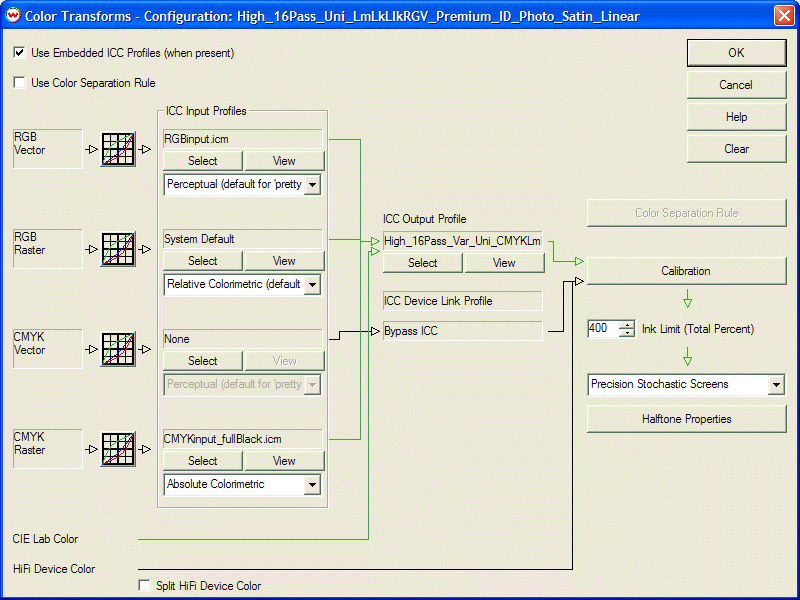
Different devices have different ranges of possible colors (different color gamuts"), and often have different paper colors or "white points". This creates special problems for color matching. The four rendering intents defined by the ICC are essentially "matching styles" that address these issues in different ways.
When new input ICC profiles are selected in the Color Transforms menu (below), Wasatch SoftRIP defaults to Perceptual rendering intent. This default is appropriate for most users, but those with more demanding requirements may wish to select others. Select rendering intent for incoming files the ICC Input Profiles controls.

This rendering intent maps color "smoothly", preserving relationships between similar colors. This prevents gamut clipping with its potential loss of detail and tonal banding problems. Gamut clipping occurs when colors that are different in the input image appear the same when printed. Perceptual rendering intent makes small compromises throughout the entire color space in order to preserve color relationships. It sacrifices some precision of in-gamut colors in order to ensure pleasing results. Perceptual intent will produce the most predictable results when printing from a wide range of image sources, for example, when printing RGB images on CMYK devices, or when trying to match CMYK devices that are radically different from each other. We consider this "foolproof" setting to be best for users who handle the wide variety of images that commonly enter large format printing facilities. It is usually not precise enough for processes where input images are well controlled, such as color proofing and giclee. Perceptual rendering intent is the setting of the default color configurations shipped by Wasatch.
When a color is not printable within the gamut of the output device, this rendering intent simply prints the closest match. It reproduces in-gamut colors without compromise, as faithfully as possible. This produces the most accurate matching of spot colors. Unfortunately, it can also result in gamut clipping where two colors that are different in the original are identical on the print. White points may also be clipped, interfering with highlights in images. Such clipping, and the resultant problems, makes this choice most suitable for work involving spot colors, or for work where it is desired to print on a bright-white paper to simulate an off-color paper. Although Wasatch SoftRIP never sets it as default, you can choose it from Wasatch SoftRIP's user interface.
When a color is not printable within the gamut of the output device, this rendering intent prints the closest match along with an adjustment that maps white to the paper of the output. This mapping of white point prevents the problems of Absolute Colorimetric when images (or anything other than spot colors) are involved. When producing color match proofs on inkjet printers, which typically have larger gamuts than the printing presses being simulated, this is a superior choice. When a pair of ICC profiles is loaded for runtime linking, one for the device to be simulated and one for the device being used, this rendering intent will provide good precision (minimal delta-E) for the match-proof process.
This preserves the saturation, or brightness of colors when transforming them for output. It maps fully saturated source colors to fully saturated target colors. This rendering intent is used where color matching and exact relationships between colors is less important than bright colors. This is a "pretty picture" intent that will produce brilliant spot colors, and although Wasatch SoftRIP never sets it as default, you can choose it from Wasatch SoftRIP's user interface.